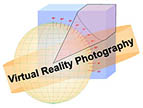

![]() Ask the VR Photography Experts
Ask the VR Photography Experts
![]()
Q: How do I figure out what the field of view for a fisheye lens is on a Nikon digital SLR?
![]()
A: The Nikkor 16mm fisheye lens is a *full frame* fisheye for the 35mm film format. That means it shows the curved fisheye distortion (straight lines in the scene appear curved in the image, unless they are centered in the frame), but the image fills the frame. Nikon claims the field of view of this lens is 180 degrees, but understand that they use the *diagonal* measure of the frame for this, not the vertical. Furthermore, lens manufacturers tend to round the focal lengths of their lenses in their promotional material, so a 16mm lens may actually have a true focal length either more or less than 16mm. Also, individual lenses may differ due to slight variations in manufacturing and optical element production.
One can use the following formula for fisheye fov calculation:
| fov = 4 * arcsin (image size/(focal length * 4)) |
A 35mm film frame has the following dimensions: 24.3mm x 35.8mm (43.3mm diagonal)
Thus, for a 16mm fisheye on the 35mm camera in portrait orientation:
| fov(y) | = | 136 degrees |
| fov(x) | = | 89 degrees |
| fov(diagonal) | = | 170 degrees |
Note that the image circle produced by the 16mm fisheye lens is slightly larger than the diagonal of the 35mm film frame, so Nikon's claim of 180 degree coverage may be fairly close to accurate, although the user won't necessarily see that coverage on film.
![]()
The image sensor dimensions on the Nikon D1 series cameras are smaller than the 35mm frame (which results in the effective focal length magnification). They are approximately: 15.6mm x 23.7mm (28.4mm diagonal)
Thus, the same 16mm fisheye lens on a D1x in portrait orientation yields the following fields of view:
| fov(y) | = | 87 degrees |
| fov(x) | = | 56 degrees |
| fov(diagonal) | = | 105 degrees |
![]()
The same formula can be used with the 8mm fisheye lenses. The difference is that the 8mm lenses are true fisheyes, rather than full-frame fisheyes like the 16mm. A true fisheye projects the full image circle of the lens within the frame of the camera, so you wind up with a circular image inside a dark field, rather than having the frame filled with the image. Note however that these 8mm lenses are designed to be true fisheyes for the 35mm camera format. The smaller sensors of digital cameras such as the D1 series crops part of the image circle, so it is no longer a true fisheye when used in this format.
The diameter of the image circle on an 8mm Nikkor fisheye (focused at infinity) is approximately 23mm. (Note that the actual focal length of most Nikkor 8mm fisheyes is about 8.2mm.) Thus, the circular field of view inside a 35mm film frame is about 178-180 degrees.
However, when this lens is used on a D1x with its smaller image sensor, the 23mm image circle is cropped on the short dimension to 15.6mm, yielding a fov of about 114 degrees. The resulting image is a cropped circle with 180-degree vertical coverage and 114-degree horizontal coverage (assuming portrait orientation).
One final note... the FC-E8 Fisheye Converter made by Nikon for its Coolpix line of digital cameras is often mistakenly referred to as an "8mm fisheye." It is not, but it produces a similar rendering on the Coolpix cameras to an 8mm true fisheye on a 35mm camera. As a supplemental lens adapter, it is far more limited in its optical quality, and any flaws or aberrations are magnified by the even smaller image sensors used in most Coolpix cameras. It does produce a circular image within the Coolpix frame, with a field of view between 184 and 186 degrees. Many photographers yield quite acceptable results with it. It is a foundation element of most iPIX digital capture kits.
![]()
To be honest, very few people actually care about the math above, and most eyes glaze over when you go into much detail about it (mine included).
The bottom line is that full frame fisheyes (such as the 16mm) would be great to use for panoramic VR photography *IF* there were good stitchers that could handle the fisheye formats. Unfortunately, there are none that I'm aware of today. The original PhotoVista software could accept fisheye images (before their settlement with iPIX rendered it inoperable with fisheyes), but the PhotoVista stitcher was never quite as good as that of QTVRAS. It produced far more stitching artifacts, and its blending algorithms left something to be desired, requiring significantly more post-production retouching in Photoshop.
Now a QTVRAS upgrade that could stitch fisheye images AND create cubic VR movies... THAT would be an upgrade we'd probably all be willing to pay for... <grin>. As far as we have been told, however, Apple has no plans to produce such an upgrade, and is leaving this in the hands of third party developers such as RealViz and VR Toolbox.
- Scott Highton